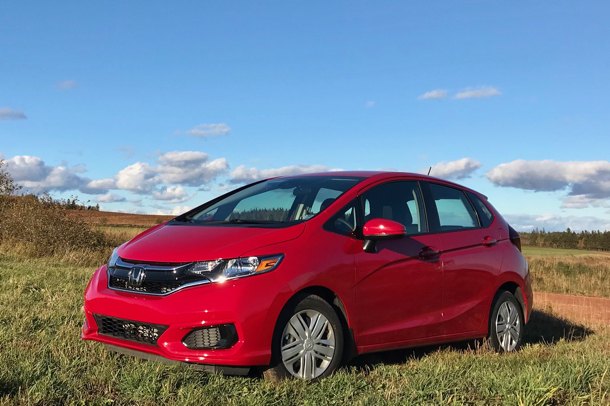2018 Honda Fit LX Review - What If It's the Only Subcompact for You?
Subcompacts, if they ever were in favor, have quickly fallen out of favor in the United States. In 2017, sales in the first three-quarters of the year plunged by more than a fifth, year-over-year. The Honda Fit, modestly updated for the 2018 model year, is on track in 2017 to fall to a five-year low of around 50,000 sales, a far cry from the nearly 80,000 American Honda sold a decade ago.
The Honda Fit, not now in third-gen form nor in any prior iteration, has never sold on the strength of style. There have always been less expensive subcompacts, faster subcompacts, and better-equipped subcompacts, as well.
There have not, however, at least not during the Fit’s tenure, been any subcompacts that offer the flexibility of the Honda Fit. But does the fact that the 2018 Honda Fit is likely the only current subcompact that could operate as my family’s lone vehicle make up for the fact that the Fit lags behind rivals in key areas?
Now entering the fourth model year of its third generation, the 2018 Honda Fit benefits from extensive availability of the Honda Sensing suite of safety gear (lane keeping assist and adaptive cruise, for example), retuned suspension, an acoustic glass windshield, and more sound insulation.
But in essence, this is the same vehicle for 2018 that it was for 2017. That means the driver’s seat doesn’t slide back quite as far as it ought to. Thigh support is nearly nonexistent, and what little soft foam support there is remains of insufficient quality. Wind noise at the A and B-pillars is excessive. Hooked up to a continuously variable transmission, the 130-horsepower 1.5-liter isn’t a particularly happy revver. Lacking the smoothness expected of a Honda four-cylinder, the 1.5 protests with a harshness that diminishes the driver’s desire to accelerate. Riding on the Fit LX’s 185/60R15 rubber, there’s not enough grip for the Fit to feel sporty, and the third-gen model doesn’t provide enough feel and interactivity to foment fun.
And yet the 2018 Honda Fit is at its core a veritable minivan, in the true sense of the word mini. Slap a pair of sliding doors on this 161-inch-long monobox and you’re about as set for the frugal school run as is possible.
Honda says there are 39.3 inches of rear legroom in the Fit and 96 cubic feet of passenger volume overall. That’s more legroom than you’ll get in the back of a Honda Civic sedan and more passenger volume than you’ll find in a Volkswagen Jetta, two cars that stretch much farther than the Fit on much lengthier wheelbases. Throw another 17 cubic feet of cargo capacity behind the rear seat and the Fit becomes an inordinately spacious subcompact car. And that’s before you introduce the adaptability of the Fit’s second-row Magic Seats, which can essentially introduce a second cargo area when you’re travelling with three passengers aboard.
But is versatility the answer if Honda demands a Fit premium? After all, Nissan Versa sedans sticker from as little as $12,875 with enough rear legroom for NBA forwards. The new Kia Rio is distinctly more refined than the Honda Fit and starts below $15,000. The Toyota Yaris iA, essentially a Mazda 2 in sedan clothes, starts below $17,000 with the fun driving mannerisms once linked to the Honda Fit.
Yes, versatility may be the answer. Yes, versatility may be such a valuable extra in an otherwise capable (if not outstanding) car because in the case of a family of four with a large dog, for example, no other car in this class can cope with our needs.
That’s always been the Fit’s claim to fame. Even if it isn’t the most attractive, the quickest, or the most affordable, or the most handsomely equipped subcompact, the Fit does what I need it to do.
Despite the newfound installation of extensive safety gear at the low end of the lineup, however, a higher grade would be tempting, largely because the 2018 Honda Fit LX appears far more poverty-spec than it actually is. Replacing these covered wheels with alloys, swapping the CVT for a six-speed manual, installing the 2018 Fit EX’s fog lights, and gaining a sunroof won’t turn the Fit into a beauty, but it will extinguish the one-lakh-car look of the Fit LX.
At $19,035, just $170 more than this $18,865 tester, the basic 2018 Honda Fit EX may well be the n0-brainer in the Fit range.
[Images: © 2017 Timothy Cain]
Timothy Cain is a contributing analyst at The Truth About Cars and Autofocus.ca and the founder and former editor of GoodCarBadCar.net. Follow on Twitter @timcaincars and Instagram.
More by Timothy Cain
Latest Car Reviews
Read moreLatest Product Reviews
Read moreRecent Comments
- 28-Cars-Later I thought Skeletor banned Tiktok?
- Kwik_Shift_Pro4X Next step is coercion.
- Kwik_Shift_Pro4X And now to see the long term consequences for such convenience. 🧐
- 28-Cars-Later Well, I can live in the mansion.
- Lorenzo Why are all these devices being invented, that take the driving out of driving? Is it because there are too many people with driver's licenses who should be taking taxi's and public transportation?





































Comments
Join the conversation
If what you want is a quieter, faster, more refined Honda Fit...buy a Chevy Bolt EV. Twice the money up front, but you make up a chunk of that with tax credits/rebates, and another chunk by never paying for gas or routine maintenance. No?
Devilsrotary-rent a Ford Fusion, Sonata, or even a Chevy Malibu for your next road trip and come back on here and let us know how it compares to you "excellent road trip" in the Fit.